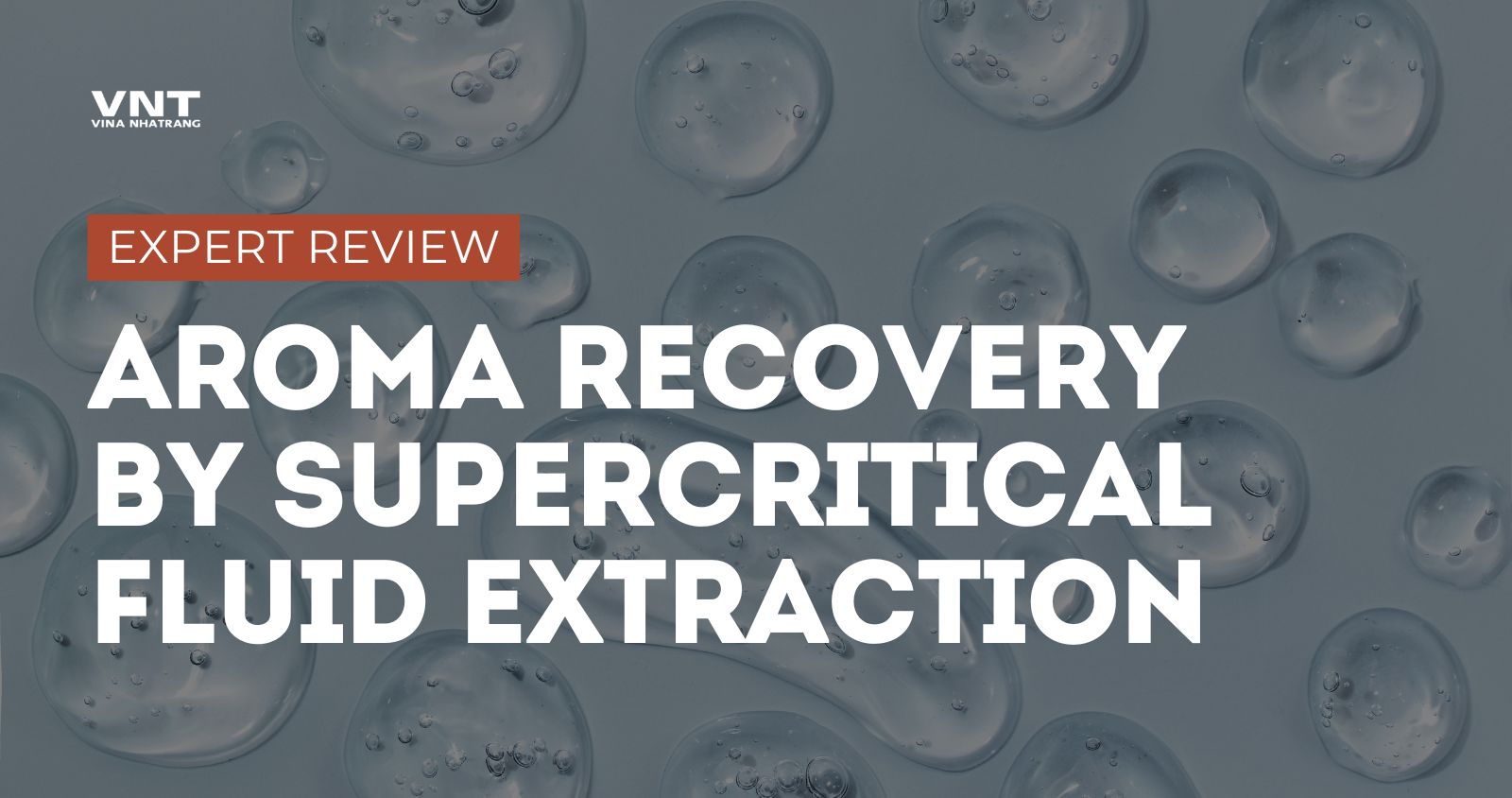Aroma is essential to the flavor and appeal of food and beverages, yet many volatile compounds are lost during processing, storage, and packaging due to heat exposure and oxidation. To preserve these delicate aromas, manufacturers rely on advanced recovery techniques, with Supercritical Fluid Extraction (SFE) emerging as one of the most effective methods.
SFE uses supercritical CO₂ to selectively extract volatile compounds without heat or chemical solvents, ensuring pure, high-quality aroma retention. Unlike traditional distillation, SFE maintains authentic flavor profiles while being eco-friendly and sustainable. This article explores the science, applications, technologies, advantages, and future of aroma recovery through SFE.
Understanding Aroma Recovery by Supercritical Fluid Extraction
What is Supercritical Fluid Extraction (SFE)?
Supercritical Fluid Extraction (SFE) is a separation process that utilizes a fluid in its supercritical state—a phase where it exhibits both liquid and gas-like properties. In this state, the fluid has the solvating power of a liquid and the diffusivity of a gas, allowing it to efficiently dissolve and extract volatile aroma compounds.
Why CO₂ is the Preferred Supercritical Fluid
- Non-toxic & Safe: CO₂ is a natural, food-grade solvent approved for use in food and beverage processing.
- Low Critical Temperature (31.1°C): Prevents heat-induced aroma degradation.
- Easily Removable: Once the extraction is complete, CO₂ is depressurized, turning it back into a gas and leaving behind a pure aroma extract without solvent residues.
- Environmentally Friendly: Unlike chemical solvents, CO₂ is non-polluting and recyclable.
How Supercritical Fluid Extraction Works
- Supercritical CO₂ is introduced into the extraction chamber, where it penetrates the food matrix.
- The fluid dissolves volatile aroma compounds, extracting them efficiently.
- The CO₂ carrying the aroma compounds is transferred to a separation chamber, where pressure is lowered.
- As CO₂ turns back into a gas, the aroma compounds are left behind and collected.
- The recovered aroma is reintroduced into the final product or stored for later use.
Industrial Applications of Supercritical Fluid Extraction in Aroma Recovery
1. Fruit Juice & Beverage Processing
Challenges:
- Heat-sensitive aroma compounds are lost during pasteurization and juice concentration.
- Traditional evaporation can strip away delicate esters and aldehydes, reducing natural freshness.
SFE Solution:
- Selectively extracts and concentrates fruit aroma volatiles while leaving behind unwanted components.
- The captured aroma compounds are reintegrated into the juice concentrate, ensuring authentic flavor.
✅ Example:
- Citrus juice aroma recovery using SFE captures limonene and valencene, preserving the fresh, natural taste.
2. Coffee & Tea Processing
Challenges:
- Traditional solvent extraction can leave behind chemical residues.
- Many volatile coffee and tea aromas are lost during roasting and brewing.
SFE Solution:
- Uses supercritical CO₂ to extract delicate coffee volatiles before freeze-drying.
- Prevents oxidation and retains fresh-roasted flavors in instant coffee.
✅ Example:
- Premium instant coffee brands use SFE to recover and reinfuse natural coffee aromas into freeze-dried granules.
3. Alcoholic Beverages & Wine Processing
Challenges:
- Alcohol removal (for low-alcohol and non-alcoholic wines) results in aroma loss.
- Many desirable esters, aldehydes, and ketones are lost in conventional de-alcoholization processes.
SFE Solution:
- Selectively removes ethanol while preserving aroma compounds, ensuring that non-alcoholic wine retains its bouquet.
- Allows manufacturers to control alcohol content without affecting aroma.
✅ Example:
- High-end de-alcoholized wines retain fruity esters like ethyl acetate and ethyl butanoate when processed with SFE.
4. Dairy & Fermented Products
Challenges:
- Heat processing in dairy can cause loss of buttery, creamy, and nutty aromas.
- Pasteurization can create unwanted “cooked” flavors.
SFE Solution:
- Selectively extracts and reintegrates dairy volatiles, maintaining the natural richness of cheese, milk, and yogurt.
✅ Example:
- Whey protein concentrate processing uses SFE to recover lactones and fatty acids that contribute to dairy aroma.
5. Essential Oils & Fragrance Industry
Challenges:
- Steam distillation can degrade delicate floral and herbal scents.
- Chemical solvent extraction can leave traces of unwanted residues.
SFE Solution:
- Gently extracts essential oil volatiles without heat damage, preserving full aroma complexity.
- Produces high-purity extracts with zero solvent contamination.
✅ Example:
- Lavender, rose, and citrus oil extraction using SFE ensures maximum fragrance retention.
Key Technologies in Supercritical Fluid Extraction for Aroma Recovery
Supercritical Fluid Extraction (SFE) is a highly selective and efficient method for recovering volatile aroma compounds while maintaining purity and natural flavor profiles. The effectiveness of SFE depends on the extraction system design, pressure control, temperature regulation, and use of co-solvents. Below are the leading technologies that enhance the efficiency of aroma recovery using supercritical CO₂ in food, beverage, and fragrance industries.
1. Supercritical CO₂ Extraction Systems
Best for: Juice, coffee, tea, essential oils, and dairy aroma recovery
Supercritical CO₂ extraction systems are the most widely used technology for aroma recovery due to their ability to operate at low temperatures while efficiently extracting volatile compounds. These systems use high-pressure CO₂ to dissolve and extract target aroma compounds while avoiding thermal degradation.
How It Works:
- CO₂ is pressurized beyond its critical point (31.1°C and 73.8 bar), achieving both liquid and gas-like properties.
- The supercritical CO₂ permeates the food or beverage matrix, dissolving volatile aroma compounds.
- The CO₂-aroma mixture is transferred to a separator chamber, where pressure is reduced.
- As CO₂ returns to its gaseous state, it releases the captured aroma compounds, which are collected and reintegrated into the final product.
✅ Advantages:
- Operates at low temperatures, preserving delicate aromas.
- Produces pure extracts without chemical solvents.
- CO₂ is fully recyclable, making the process eco-friendly.
❌ Limitations:
- Requires precise pressure and temperature control.
- High initial investment cost for equipment.
✅ Used in:
- Citrus juice aroma recovery (limonene, valencene).
- Instant coffee processing to retain fresh-brewed aromas.
- Dairy flavor extraction (buttery, creamy volatiles).
2. Fractional Supercritical Extraction
Best for: Wine aroma preservation, dairy volatiles, and perfume extraction
Fractional extraction enhances selectivity by separating multiple aroma fractions at different pressures. This allows manufacturers to recover complex aroma profiles without mixing unwanted volatiles.
How It Works:
- Supercritical CO₂ is passed through the sample at different pressure levels, allowing for the stepwise extraction of different aroma compounds.
- Lighter aroma molecules (such as fruity esters) are extracted at lower pressures, while heavier volatiles (like fatty acids) are captured at higher pressures.
- Each fraction is collected separately, ensuring maximum control over aroma balance.
✅ Advantages:
- Allows for precise aroma separation.
- Prevents loss of delicate top notes in beverages and fragrances.
- Ideal for products requiring multi-layered aroma profiles.
❌ Limitations:
- More complex system setup than standard SFE.
- Requires multiple extraction chambers, increasing costs.
✅ Used in:
- Wine de-alcoholization while preserving floral and fruity esters.
- Dairy processing for concentrated cheese and butter flavors.
- Luxury perfume extraction (e.g., rose, vanilla, jasmine scents).
3. Supercritical CO₂ with Co-Solvents
Best for: Complex food aromas, herbal extracts, and pharmaceutical applications
In some cases, pure CO₂ alone is not sufficient to extract certain aroma compounds. Adding a co-solvent (such as ethanol or water) improves the solubility of polar and semi-polar molecules, making the extraction process more effective.
How It Works:
- A small percentage (1-10%) of a co-solvent (such as ethanol) is mixed with CO₂.
- The modified CO₂ mixture enhances extraction efficiency for specific aroma compounds.
- The co-solvent is then removed through evaporation or distillation, leaving a pure aroma extract.
✅ Advantages:
- Improves extraction of polar compounds (e.g., plant phenols, antioxidants).
- Allows broader spectrum aroma recovery.
- Enhances the yield of complex fragrance molecules.
❌ Limitations:
- Requires an extra purification step to remove co-solvents.
- Slightly higher energy consumption compared to pure CO₂ extraction.
✅ Used in:
- Herbal and botanical aroma recovery (e.g., green tea, chamomile, peppermint).
- Pharmaceutical-grade food extracts (e.g., vanilla, ginger, turmeric oils).
- Complex fruit juice aroma profiles (e.g., passionfruit, guava, mango volatiles).
4. Supercritical Fluid Chromatography (SFC) for Aroma Isolation
Best for: High-precision aroma fractionation in food and beverage industries
Supercritical Fluid Chromatography (SFC) combines the separation capabilities of chromatography with supercritical CO₂ extraction, allowing manufacturers to precisely isolate aroma compounds with high purity.
How It Works:
- Supercritical CO₂ acts as a mobile phase, carrying volatile aroma compounds through a chromatographic column.
- As the CO₂ moves through the column, different aroma molecules separate based on their chemical properties.
- The fractions are collected separately, allowing for high-purity aroma isolation.
✅ Advantages:
- Produces extremely pure aroma extracts.
- Ideal for high-end food and beverage processing.
- No thermal degradation due to low operating temperatures.
❌ Limitations:
- Higher operational costs due to complex instrumentation.
- Requires skilled operators for precise control.
✅ Used in:
- Premium wine aroma fractionation (separating fruity esters from alcohols).
- Isolation of delicate floral notes in fragrance manufacturing.
- High-purity spice extraction (e.g., saffron, cinnamon, nutmeg oils).
5. Continuous Flow Supercritical Extraction Systems
Best for: Large-scale aroma recovery in industrial food production
Unlike batch extraction, continuous flow SFE allows for non-stop processing, making it highly efficient for large-scale beverage and food applications.
How It Works:
- CO₂ is continuously circulated through an extraction column, maintaining a steady flow of aroma extraction.
- The aroma-loaded CO₂ moves to a separator unit, where volatiles are collected while CO₂ is recycled.
- This process allows for continuous, high-volume aroma recovery without downtime.
✅ Advantages:
- Higher efficiency and throughput for industrial-scale production.
- Reduced CO₂ consumption due to recycling capabilities.
- Lower operational costs over time.
❌ Limitations:
- Requires a significant initial investment.
- Less flexibility for small-batch, high-end extractions.
✅ Used in:
- Mass production of fruit juice concentrates with retained aromas.
- Coffee and tea processing for large-scale flavor retention.
- Industrial fragrance and essential oil extraction.
Comparison of Key Supercritical Fluid Extraction Technologies
| Technology | Best For | Main Advantage | Key Limitation |
|---|---|---|---|
| Supercritical CO₂ Extraction | Coffee, tea, juice, dairy | Low-temperature, solvent-free | Requires precise pressure control |
| Fractional Supercritical Extraction | Wine, dairy, perfumes | Selective multi-fraction aroma capture | More complex system design |
| Supercritical CO₂ with Co-Solvents | Herbal, fruit juice, pharma | Enhances extraction efficiency | Requires extra purification |
| Supercritical Fluid Chromatography | High-precision aroma isolation | Extremely pure extracts | High operational cost |
| Continuous Flow Supercritical Extraction | Large-scale food/beverage | High efficiency, continuous processing | High initial investment |
Conclusion
Supercritical Fluid Extraction offers a highly selective, solvent-free, and eco-friendly solution for aroma recovery across the food, beverage, and fragrance industries. With advancements in fractional extraction, chromatography integration, and continuous-flow processing, SFE is rapidly becoming the gold standard for high-quality aroma retention.
References: Information sourced from Karlsson & Trägårdh (1997) on aroma recovery during beverage processing.




